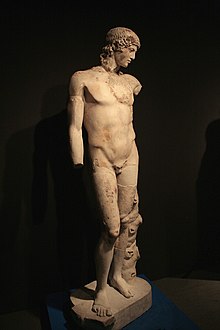Tiberapoll
The Tiberapoll is an ancient statue. It is a Roman marble copy of a from around 460 BC. Originals from the Greek early classical period ( strict style ). The Tiberapoll was found in the bed of the Tiber in 1891 - hence the name "Tiberapoll" - and brought to the Thermenmuseum in Rome . The right shoulder, the upper part of the left thigh, the right leg including the foot, the left foot and the calf, the lower half of the support and the right lower leg had to be added to the statue. The work is seen as a possible archetype for many works of the 2nd century. The god is shown naked in classical contrapost . The left one is the standing leg , the right one the free leg . In the Roman copy, a statue support is attached to the left leg of the statue . The curly hair on the head, which is tilted slightly to the left, is kept in shape by a tänie .
Shortly after the discovery, still in a provisional composition of the statue fragments, casts of the statue were made, which contributed to the great international fame of the statue. Today there are casts in the Basel sculpture hall and the archaeological collections of the University of Göttingen , the University of Bonn and the University of Erlangen .
literature
- Paul Zanker : Classicist statues. Studies on the change in taste in art during the Roman Empire , von Zabern, Mainz 1974.
Web links
- Statue of Apollo in the Arachne archaeological database
- Tiberapoll - Göttingen cast
